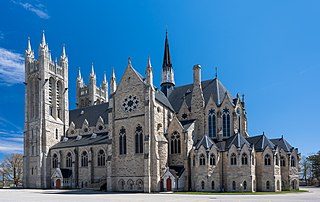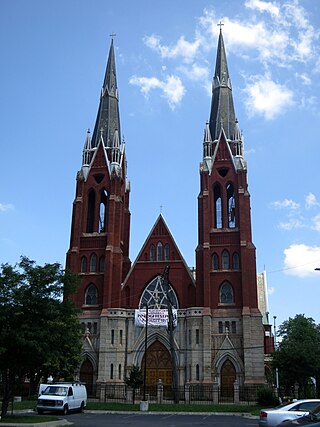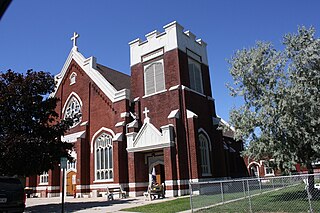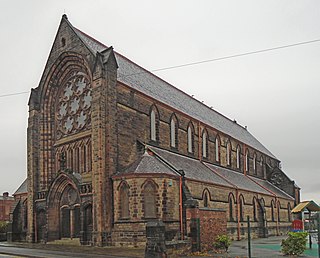
St. Michael's Cathedral Basilica is the cathedral church of the Roman Catholic Archdiocese of Toronto, Canada, and one of the oldest churches in Toronto. It is located at 65 Bond Street in Toronto's Garden District. St. Michael's was designed by William Thomas, designer of eight other churches in the city, and was primarily financed by Irish immigrants who resided in the area. The cathedral has a capacity of 1600. John Cochrane and Brothers undertook the work on the stone and stucco ornamentation of the interior.

The Church of St Clare is on the corner of Arundel Avenue and York Avenue in the Sefton Park area of Liverpool, Merseyside, England. It is recorded in the National Heritage List for England as a designated Grade I listed building, and is an active Roman Catholic parish church in the Archdiocese of Liverpool and the Pastoral Area of Liverpool South. It is the only Grade I listed Roman Catholic church in the Archdiocese of Liverpool. Sharples and Pollard consider it to be "one of the most imaginative churches of its date in the country".

The Cathedral Basilica of the Immaculate Conception is a cathedral serving Roman Catholics in the U.S. city of Mobile, Alabama. It is the seat of the Archbishop of the Roman Catholic Archdiocese of Mobile. The cathedral is named for Mary, mother of Jesus, under her title, Our Lady of the Immaculate Conception. It is listed on the National Register of Historic Places as a contributing property to the Church Street East Historic District and Lower Dauphin Street Historic District and is listed on the Historic Roman Catholic Properties in Mobile Multiple Property Submission

The Church of Saint-Germain-des-Prés is a Roman Catholic parish church located in the Saint-Germain-des-Prés quarter of Paris. It was originally the church of a Benedictine abbey founded in 558 by Childebert I, the son of Clovis, King of the Franks. It was destroyed by the Vikings, rebuilt, and renamed in the 8th century for Saint Germain, a 6th century bishop. It was rebuilt with elements in the new Gothic style in the 11th century, and was given the first flying buttresses in the 12th century. It is considered the oldest existing church in Paris.

Basilica of Our Lady of the Immaculate Conception is a Roman Catholic minor basilica and parish church in Guelph, Ontario, Canada. A Gothic Revival style building constructed between 1876 and 1888 by architect Joseph Connolly, it is considered Connolly's best work. The monumental church contains decorative carving and stained glass executed by skilled craftsmen. The church of Our Lady is one of the 122 parishes in the Diocese of Hamilton and currently has 2,600 families in the congregation.

St. Stephen Church and Rectory is a registered historic building in Hamilton, Ohio, listed in the National Register on 1982-07-29. Located in Hamilton's German Village Historic District, the church building is home to Saint Julie Billiart Catholic Parish, an active parish in the Roman Catholic Archdiocese of Cincinnati.

St Michael's Church is in St Michael's Road, Ditton, Widnes, Halton, Cheshire, England. It is recorded in the National Heritage List for England as a designated Grade II* listed building. It is an active Roman Catholic church.

The Sweetest Heart of Mary Roman Catholic Church is located at 4440 Russell Street in Detroit, Michigan, in the Forest Park neighborhood on the city's central East side. The Gothic Revival cathedral styled church is the largest of the Roman Catholic churches in the City of Detroit. It was designated a Michigan State Historic Site in 1974 and listed on the National Register of Historic Places in 1978. It, along with St. Albertus Roman Catholic Church, 0.4 miles east on East Canfield Street, and St. Josaphat Roman Catholic Church, 0.3 miles west at East Canfield Street and Chrysler Drive, served the large Polish community through most of the twentieth century. In a diocesan reorganization instituted by Archbishop Allen Vigneron in 2013, Sweetest Heart of Mary joined with St. Josephat to form Mother of Divine Mercy Parish.

St. Mary Catholic Church is a parish of the Roman Catholic Church in Indianapolis, Indiana, in the Archdiocese of Indianapolis.

St Mary Star of the Sea is a Roman Catholic parish church in West Melbourne, Victoria, Australia. The foundation stone of the church was laid in 1882 and the building was completed by 1900. Since 2002, restoration has been ongoing to restore the church to its original state. Built with seating for over 1,200 people, it has been described as the largest parish church in Melbourne, in Victoria, or even in Australia.

Sacred Heart Church is a Roman Catholic church in Blackpool, Lancashire, England, on Talbot Road close to the town centre. It was the first Roman Catholic church built in Blackpool and has been designated a Grade II* listed building by English Heritage.

The Concatedral Dulce Nombre de Jesús or in English, Co-Cathedral of the Sweet Name of Jesus, is a Catholic cathedral located on the town plaza in Humacao, Puerto Rico. Along with the Catedral Santiago Apóstol in Fajardo it is the seat of the Diocese of Fajardo-Humacao.

St. John the Baptist Catholic Church, now used as the Menominee County Historical Museum, is a historic church at 904 11th Avenue in Menominee, Michigan. It was added to the National Register of Historic Places in 1995 and designated a Michigan State Historic Site in 1981.

The Church of St Vincent de Paul is a Roman Catholic parish church in Park Lane, Liverpool, England. It is an active parish church in the Archdiocese of Liverpool and the Pastoral Area of Liverpool South. The church is recorded in the National Heritage List for England as a designated Grade II* listed building.

The second St Mary's Roman Catholic Church is a heritage-listed sandstone Catholic church at 163 Palmerin Street in Warwick in the Southern Downs Region, Queensland, Australia. It was designed by Dornbusch & Connolly and built from 1920 to 1926. It is also known as St Mary of the Assumption Church. It was added to the Queensland Heritage Register on 21 October 1992.

St Mary's Church is in Church Road, Woolton, Liverpool, Merseyside, England. It is an active Roman Catholic parish church in the Liverpool South Deanery of the Archdiocese of Liverpool. The church is recorded in the National Heritage List for England as a designated Grade II listed building.

The Church of Our Lady Star of the Sea is in Wheatland Lane, Seacombe, Wallasey, Wirral, Merseyside, England. It is an active Roman Catholic parish church in the diocese of Shrewsbury, and its parish is combined with that of St Joseph, Wallasey. The church is recorded in the National Heritage List for England as a designated Grade II listed building.

St Joseph's Church is in Skeffington Road, Preston, Lancashire, England. It is an active Roman Catholic church in the Diocese of Lancaster. The church is recorded in the National Heritage List for England as a designated Grade II listed building.

St Josephs Cathedral is a heritage-listed Roman Catholic cathedral at 170 William Street, Allenstown, Rockhampton, Rockhampton Region, Queensland, Australia. It was designed by Francis Drummond Greville Stanley and built from 1893 to 1982. It was added to the Queensland Heritage Register on 21 October 1992. The cathedral serves as the seat for the Bishop of Rockhampton.

St Patrick's Church is a heritage-listed Roman Catholic church at Church Street, Gympie, Gympie Region, Queensland, Australia. It was designed by Francis Drummond Greville Stanley and built from 1883 to 1935. It was added to the Queensland Heritage Register on 20 February 1995.
























